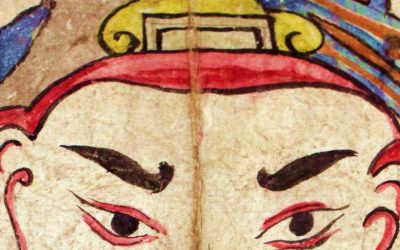In Chinese culture there are many historical and folkloric stories that extolled dogs, placing the animal friend above the other human beings. This was due to the dogs fidelity to their master, one of the most appreciated virtues in Chinese society. In legends, popular tales and dynastic stories of China there are a good number of canine characters popularly known for their special loyalty to their master. One of the most moving stories of love of canine love is The Faithful Dog.
The faithful dog.
“During the Tai-Ho period (366-371) of the Tsin dynasty, a man named Yang of Kuangling had a dog to which he was very much attached. He took it wherever he went. Once he fell into a drunken sleep in the marshland just when men came to burn the reeds, for it was winter and there was a strong wind. The dog took fright and howled, but Yang was too drunk to realice his danger. Since there was a pool in front, the dog plunged into it, coming back to sprinkle water on the grass all around. It did this several times, describing a circle, until all the grass around was wet. Thus when the fire reached them they were not burned. Yang knew nothing of this till he woke.
On another occasion, walking in the dark, Yang fell into an empty well. His dog howled till morning when a man passed by and was surprised to find a dog howling there. Upon looking into the well he discovered Yang.
“If you get me out, sir,” said Yang, “I promise to repay you well.”
“Give me this dog and I will.”
“This dog has saved my life. I can’t give it away. Ask me for anything else.”
“In that case, stay where you are.”
Then the dog looked down into the well and Yang understood its meaning.
“Very well,” he told the passer-by. “You shall have the dog.”
At that the fellow helped him out, tied a rope round the dog’s neck and led it away.
Five days later the dog came back to Yang by night (Yang and Yang 1990: 86).
In another version the fire is caused by the governor during hunting. The faithful dog finishes dead beside his master, exhausted by the effort of running many times to the river to save the master from the fire, and the governor, astonished by its loyalty, orders that a temple be erected to venerate it; a temple that is situated in Shandong province.
Tales of faithful dogs
Tales of faithful dogs exist where there are dogs, for they are a reflection of the fidelity that they invariably show towards their masters.
One of the most widespread in Asia, used to educate young people in the need to think before acting, is also called The faithful dog, although its story line is different. We bring here the version that circulates among the Mongols, in which the protagonist curiously is a fox instead of a dog.
The faithful dog among the Mongols
“There was a hunter and his wife who lived very well and happily. Then a son was born to them. Once the hunter caught a baby fox and brought him home to his son as a gift. The little fox was very nimble and mischievous. The boy became very fond of him. His mother often left the two together and went to help her husband. And when she returned, the little fox would run to meet her, jump about merrily, and turn somersaults.
Thus the days passed by.
But once when she returned at midday she was surprised that the little fox did not run to meet her as always, but sat near the threshold and whined pitifully. And she noticed that he was all covered with blood.
“Oh my, oh my, the animal has torn my child to bits!” The woman cried.
And she grabbed a stone, struck the little fox, and with a terrible howl ran into the ger. There she saw her little son. He was laughing merrily and clapping his hands. And next to him lay a large dead snake which had been torn to pieces.
“Oh my, oh my” the woman wept. “What have I done!”
And she swore at herself for having been so hasty (Luvsanjav and Travers 1987: 160).
Saint Guinefort
There are similar stories in many regions of the word. In Welsh is Gelert the dog who saves the children from a wolf attack and which suffers an unfair death at the hands of his master, Prince Llywelyn (Johnson). Among the Romans there were several versions of the tale, one of the most popular was The Greyhound, the Serpent, and the Child, in which the attacking beast was a snake. All these tales belongs to the Aarne-Thompson-Uther type 178A (Ashliman).
Perhaps the history that had the greatest social and historical impact was the legend responsible for the emergence of the cult of Saint Guinefort, the only dog saint, in the south of France. For his owner, realizing that he had killed his faithful dog for his lack of reflection, buried him in a beautiful tomb, which soon began to be revered by the people.
Then a a shrine to Guinefort was established in the site, and for many centuries the pilgrims traveled to the tomb of St. Guinefort when their children were sick, to be healed through various rituals, such as passing naked babies between the trunks of trees.
Historians say that Guinefort the dog saint assumed the name of little known saint of the same name. Anyway the Catholic Church disliked the cult to Saint Guinefort and tried to put an end to it. “In 1262, Inquisitor Etienne de Bourbon demanded that the remains of the dog be burned and the shrine and surrounding trees be completely destroyed. The church decreed that anyone found even going to the site of the former shrine would have all their possessions seized and sold (Dogster)” Despite this threat, Saint Guinefort did not disappear definitively from the sanctuary until the beginning of the 20th century.
References
Ashliman, D.L. Llewellyn and His Dog Gellert and other folktales of Aarne-Thompson-Uther type 178A.
Ceinos Arcones, Pedro. La Magia del Perro en China y el mundo. 2018.
Dogster. We Remember Guinefort, the Greyhound Who Was a Saint.
Johnson, Ben. The Legend of Gelert the Dog. In historic UK.
Luvsanjav, Choi y Travers, Robert (eds.). How Did the Great Bear Originate? Folktales from Mongolia. Ulaanbaatar. 1988.
Yang Hsien-Yi and Yang, Gladys. The man who sold a ghost. Chinese tales of the 3rd-6th centuries. Foreign Languages Press. Beijing. 1990.
About me: I have spent 30 years in China, much of the time traveling and studying this country’s culture. My most popular research focuses on Chinese characters (Chinese Characters: An Easy Learning Method Based on Their Etymology and Evolution), Matriarchy in China (there is a book with this title), and minority cultures (The Naxi of Southwest China). In my travels, I have specialized in Yunnan, Tibet, the Silk Road, and other lesser-known places. Feel free to write to me if you’re planning a trip to China. The travel agency I collaborate with offers excellent service at an unbeatable price. You’ll find my email below.
More post in this web
Does the Daodejing Contain the Oldest Creation Myth of China?
Does the Daodejing Contain the Oldest Creation Myth of China? An introductory article on Chinese mythology asserts (twice) that the myth of the creation of Huangdi (the Yellow Emperor) should be considered one of China's creation myths, following the model of...
This book will challenge all what you know about the religion of China
Paper, Jordan. The Spirits are drunk. Comparative approaches to Chinese religion. SUNY Press. 1995 This is a completely original book on the religions of China. Instead of following the repetitive mantra of the existence of three religions and describing them more or...
The Stone Forest: A Natural Wonder Just a Step Away from Kunming
The Stone Forest: A Natural Wonder Just a Step Away from Kunming The Stone Forest (石林) is the star attraction in the Kunming area. Located 86 kilometers from the city, it is an extensive labyrinth of sharp limestone pinnacles, some reaching up to thirty meters in...
The Bull that Shaped the World and Other Sacred Bovines among the Bulang Minority
The Bull that Shaped the World and Other Sacred Bovines among the Bulang Minority The Bulang people (布朗族), an Austroasiatic ethnic group primarily inhabiting Yunnan’s tea-growing highlands, revere the ox as a sacred being intertwined with creation, agriculture, and...
The Lahu Matriarchy: An Egalitarian Dyadic Society in China
The Lahu Matriarchy: An Egalitarian Dyadic Society in China From the book: Mothers, Queens, Goddesses, Shamans: Matriarchy in China (Miraguano, Madrid, 2011) The egalitarian society of the Lahu drew academic attention with Du Shanshan’s study Chopsticks Only Work in...
The Wenzi Begins: Echoes from a Forgotten Taoist Voice
The Wenzi Begins: Echoes from a Forgotten Taoist Voice The Wenzi (文子) is an ancient Daoist text attributed to a disciple of Laozi. Although its authenticity has been debated throughout history, its content clearly reflects the Daoist worldview and its influence on the...










